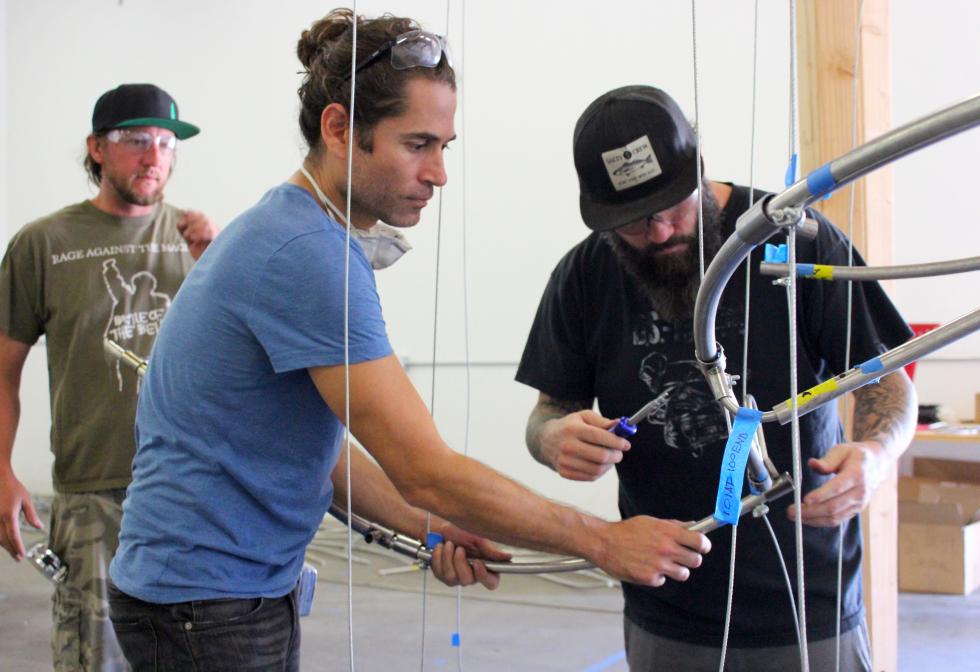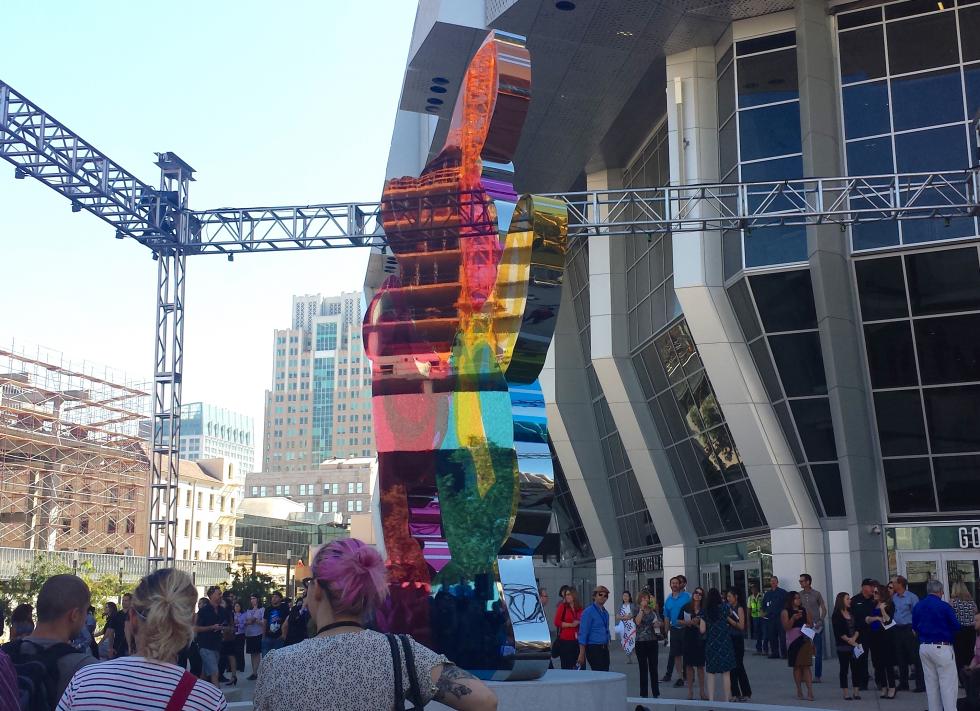Bryan Valenzuela is distracted. He strides into the warehouse in an industrial area of Sacramento, his shoulders back and chest out, wearing dark jeans, black combat boots and a plaid shirt, with his jaw firmly set and dark eyes intent. He barely notices me. “Oh, I totally spaced on you coming here today,” he says, with a smile, before grabbing a tool and walking back to the front to pull open the garage door, a harsh screech drowning out the sounds of the Gorillaz song “Some Kind of Nature.” The British virtual band convinced Lou Reed to sing on their album, and his melancholy-monotone voice fills the air with the chorus:
Some kind of nature
Some kind of soul
Some kind of mixture
Some kind of gold
Some kind of majesty
Some chemical load
Valenzuela and his childhood friend Jay Campbell, who has carpentry experience, unload wooden beams from a truck bed after a quick Home Depot run. For most of the past year, Valenzuela has worked on this project — a massive sculpture — alone, until recently when Campbell joined, along with Dietrich Motto and Luis Magana, art handlers that work at the California State Capitol Museum and Crocker Art Museum respectively.
Bryan Valenzuela saws wood to create a table as part of the prep
work in a Sacramento warehouse for his sculpture, “Multitudes
Converge.”

The sculpture, “Multitudes Converge,” will illustrate the convergence of the Sacramento and American rivers. About 190 glass balls line the edges of the warehouse with blueprints for their use tacked to a wall. In the middle of the space, cables hang down from metal poles positioned across a wooden frame to form the basic skeleton of the sculpture, which will consist of roughly 400 glass blown spheres suspended on the cables and curved stainless steel spines hung from the ceiling above an escalator at the Golden 1 Center in downtown Sacramento. The men are creating this structure in the warehouse to test its safety and solidity; Valenzuela worked with structural engineers and architects in conceiving the piece. He stops to ask the men how it’s going. They answer positively. “Keep rocking,” he says, satisfied.
Soon, the remaining deliveries of glass balls will arrive from Prague, the factory site for Franz Mayer of Munich, a world-famous glass studio in Germany. Valenzuela visited both Prague and Munich during the course of this project. But on this late-August day, he is doing the much-less glamorous part of creating an original, large-scale piece of art. He’s doing the prep. He’s searching for the right Phillips screwdriver. He’s sawing wood to make a worktable. He’s waiting on deliveries. He’s making endless trips to Home Depot.
“Multitudes Converge” will incorporate 400 glass blown spheres.

Valenzuela has until early October to install his sculpture inside the new downtown arena. He is one of four artists chosen to showcase their creations — all to be owned by the public — and one of two based in Sacramento. With the exception of world-renowned pop artist Jeff Koons, the other three were selected out of 136 applications submitted to the Sacramento Metropolitan Arts Commission.
“This is crunch time,” Valenzuela says.
Swimming Around His Head
Valenzuela spent much of his childhood in the Sierra Nevada foothills, after his family moved north from Southern California. He earned an art degree from Sacramento State, and for more than a decade, he has lived in Midtown and participated in dozens of group and solo shows throughout the area. He was one of 20 artists commissioned to beautify utility boxes downtown (his designs are located on the corners of 8th and O streets and 7th Street and Capitol Avenue). He can also be found composing music and on stage as the lead singer of the band Exquisite Corps.
Now on this last day of August, Valenzuela is back in the warehouse, which doesn’t look much different than the day prior — except for more sets of spines, which will eventually thread together and support the glass spheres. After assembling and labeling the spines, the crew disassemble them for the real installation inside the arena. It’s a tedious, math-heavy process. “I have never done anything like this ever,” Campbell says, during a brief break. “We’ve been friends almost 20 years now and he just called me up one day and asked, ‘You interested?’ And I said, ‘Absolutely.’”
Bryan Valenzuela (left) and Jay Campbell work on the spines of
the sculpture in a Sacramento warehouse in mid-August, as Matt
Dowd watches.

Today, the crew has been joined by a new member: Matt Dowd, another childhood friend of Valenzuela’s. “We’re like brothers,” says Dowd, who has 20-plus years of construction experience. He got back from Burning Man the day before where he helped install art. “It’s a little different environment than in here,” Dowd says, chuckling. “But it’s all teamwork. This has been some learning as you go, some improvisation.”
Related: Selected Artists Tour Golden 1 Center Site
Most of Valenzuela’s art involves painting and drawings to be inspected up close. “Multitudes Converge” is definitely a departure. The sculpture’s glass spheres come in three sizes (12 inches, 16 inches and 20 inches in diameter) and of varying shades of blue and turquoise, speckled with gold.
“A lot was swimming around my head when I first came up with the idea,” Valenzuela writes in an email, now in mid-September, a couple weeks before his deadline. “Sort of nebulous at first. I wanted to create something that was site specific. Something for the space. For the region even. Something that dealt with the natural light cascading through the window. I knew that particular window was situated so the afternoon and evening sun would beam right through really intensely and effect whatever I decided to do. Using glass was a way to use the light really — to capitalize on the environment, play with shadows and reflections of color in the space. Much like the reflections and highlights of water itself. Glass is kind of the most ideal material to be able to recreate the feel of liquid in a solid, durable form.”
Public Art Unveiled
Today, Sept. 26, I’ve joined a couple hundred other people at the Golden 1 Center for a preview of some of the public art (it’s not yet all done). The Kings paid most of the $8 million cost of the Koons’ piece, and the City of Sacramento contributed the remaining $2.5 million. The three other pieces were made possible with a $1 million donation from Marcy Friedman. They include art by contemporary artist Gale Hart, of Sacramento, who is creating several sculptures to symbolize a traditional dart game. Bill Fontana, of San Francisco, is making a sound sculpture using 34 small loudspeakers placed among the plants in the plaza that will play a mix of natural and basketball sounds.
The Jeff Koons sculpture is unveiled at the Golden 1 Center.

The affair is as one would expect, with the requisite speakers — Mayor Kevin Johnson, Kings Chairman Vivek Ranadive, Kings President Chris Granger — and then a collective 3-2-1 countdown to the unveiling of the centerpiece of the arena’s art: an 18-foot-tall, reflective sculpture of Piglet (Winnie-the-Pooh’s sidekick) by Koons in the public plaza. Piglet is part of Koons’ “Coloring Book” series. Ranadive tells the audience he met Koons in the Swiss Alps at the World Economic Forum several years ago, and the idea of commissioning a “Coloring Book” creation had “haunted him ever since.” He says the world’s best arena should feature art by the world’s best artist. Koons also says a few words at the microphone.
Before the unveiling of Piglet, inside the facility’s southwest entrance, Valenzuela greets the many visitors who come to pay their compliments. His sculpture is now about half-installed and he’s eager to get back to work after the festivities. “It’s been really intense,” he says of these remaining days. He looks up to the piece, where his friends Campbell and Dowd continue to screw in cables.
“I feel very honored to have my art owned by the city and for me to be representing the artists that work here,” Valenzuela says. “There are a lot of amazing artists I respect in this city, and to create public art … is like a dream come true.”



